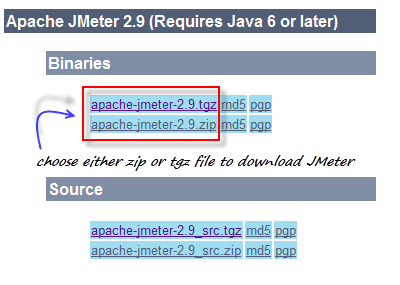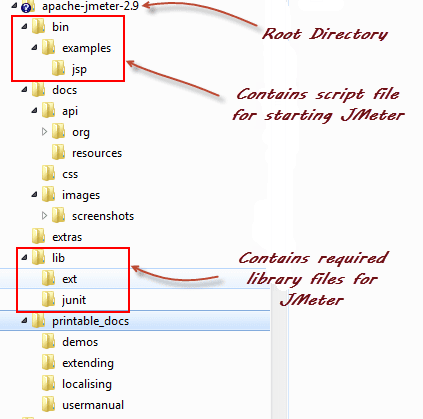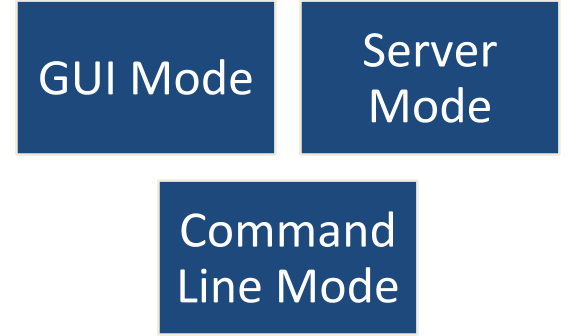What is Apache JMeter?
Apache JMeter is open source programming, a 100% unadulterated Java desktop app, intended to stack test functional conduct and measure execution of sites. It was initially intended for load testing of web apps however it has since then very well extended to other test functions.
You can utilize JMeter to investigate and quantify the exhibition of web application or an assortment of administrations. Performance Testing implies testing a web application against substantial load, various and simultaneous user traffic. JMeter initially is utilized for testing Web Application or FTP application. These days, it is utilized for a functional test, Database server test, and so forth
Want to Become a Java Certified professional? Join HKR Java Certification Training by Industry Experts!
Steps to Install JMeter
Step 1) Install Java
As we have already learned that JMeter is a pure Java desktop app, it requires a completely agreeable JVM 6 or higher. You can download and introduce the most recent rendition of the Java SE Development Kit.
After the installing process is done, you can utilize the accompanying methodology to check whether Java JDK has gotten successfully installed in your framework or not
- Step- In your Window/Linux pc, go to the Terminal option
- Thereafter then enter the following command- java -version
If the Java runtime environment is installed successfully, you will see the output as the figure below
In the event that the Java runtime condition has been introduced effectively, you will be able to view the following output

If you see that nothing has been displayed, then you will have to re-install the Java SE runtime environment
Step 2) Download Jmeter

Step 3) Installation
The installation of JMeter is amazingly simple and straightforward. You basically unzip the compress/tar document into the catalog where you need JMeter to be introduced. There is no tiresome installation screen to manage! Basically, unfasten and you are finished!

Jmeter Training
- Master Your Craft
- Lifetime LMS & Faculty Access
- 24/7 online expert support
- Real-world & Project-Based Learning
When the unfastening is done installation directory structure should look like as the figure below

Step 4) Launch the JMeter
The developer can start the JMeter in 3 modes

What are the main elements of Apache JMeter?
The main elements of Apache JMeter are-
Test Plan
A test plan is the top-level component of JMeter, clarifies the grouping of steps that execute at run time. A test plan is made up of Thread Groups, Sampler, rationale controller/s, audience/s, clock/s, declarations/, and setup components. Every Sampler can be preceded before by at least one Pre-processor component, trailed by the Post-processor component, as well as the Assertion component.
Thread Group
A Thread Group is a lot of strings executing a similar situation. It is the base component for each JMeter test plan.
There are numerous string bunches accessible which can be designed to mimic how the clients collaborate with the application, how the heap is kept up, and over what timeframe.
Controllers
JMeter has two sorts of Controllers: Samplers and Logical Controllers. These drive the handling of a test. Samplers advise JMeter to send requests to a server.
Listeners
- Listeners show the aftereffects of the test execution. They can show brings about an alternate configuration, for example, a tree, table, chart or log document
- Listeners can be included anyplace in the test, including legitimately under the test plan. They will gather information just from components at or underneath their level.
Timers
By default, a JMeter string executes samplers in grouping without stopping. We prescribe that you determine a deferral by including one of the accessible clocks to your Thread Group. In the event that you don't include a postponement, JMeter could overpower your server by making such a large number of solicitations in a short measure of time.
Assertions
Assertions are utilized to approve the sampler reaction got from the server. So as to test a sampler reaction, we add various affirmations to the sampler. In the event that an attestation falls flat, the sampler reaction is set apart as disappointment and the equivalent gets reflected in the test outcomes.
Want to Become a Master in Jmeter? Then visit here to learn the Jmeter Training onlineConfiguration Elements
Configuration Elements in JMeter are utilized to design or change the sampler demands made to the server. These components are included at the equivalent or more significant level of the samplers they need to design.
Pre-Processor Elements
A Pre-Processor executes some activity before a Sampler Request being made. On the off chance that a Pre-Processor is joined to a Sampler component, at that point it will execute only before that sampler component running.
A Pre-Processor is regularly used to alter the settings of a Sample Request not long before it runs, or to refresh factors that aren't extricated from reaction content.
Post-Processor Elements
A Post-Processor executes some activity after a Sampler Request has been made. In the event that a Post-Processor is joined to a Sampler component, at that point it will execute soon after that sampler component runs.
A Post-Processor is regularly used to process the reaction information, frequently to remove esteems from it

Subscribe to our YouTube channel to get new updates..!
Working of JMeter
The Apache JMeter™ application is open source programming, a 100% unadulterated Java application intended to stack test practical conduct and measure execution. It was initially intended for testing Web Applications yet has since extended to other test capacities.
Introduce JMeter on your framework from where you need to run your test. I am utilizing Mac OS for running Jmeter and utilizing blend to introduce JMeter.
brew install JMeter
We first need to check document descriptors we can open on our framework utilizing underneath order. Each OS has constraints on dynamic record descriptors. Each TCP association takes a record descriptor, so we have to ensure we have enough document descriptor (can set between 1–65535) to run simultaneous solicitations.
limit –n
To begin our load test, we have to begin with string gatherings. They are the starting purpose of any test plan. We can determine the number of clients (= number of strings) that we need to recreate simultaneously. Set increase time which determines the measure of time it takes to begin all strings.
- We have to characterize various emphases for each user(thread) in the gathering. Each string executes the arrangement freely from different strings. All components inside a single string will execute consecutively.
- We can include samplers and rationale controllers in a string gathering. Samplers help send a solicitation to a server and sit tight for a reaction, for example, HTTP demand sampler to send HTTP to ask for and get the reaction. Rationale controllers help tweak the rationale to choose when to send a solicitation, adjust demand, and so on.
Note: Audience members are another sort of composition which we can include a string gathering. They give access to data about our load test. Chart result audience helps plot aftereffects of our test. View result tree audience shows the detail of solicitation and reaction.
- We can include pre-processor and post-processor to a sampler demand. Pre-processor executes characterized activity before test solicitation and post-processor executes characterized activity after example demand.
- Pre-processor can be utilized to produce dynamic parameters diverse for each solicitation and post-processor to bring reaction parameters to be utilized by different solicitations. Config components are utilized to design default an incentive for the samplers.
- How about we take a certifiable model where we will make a JMeter test plan with a string bunch that can run CRUD procedure on client assets at a given server.
- Each "create client" activity needs to have diverse email address haphazardly produced before sending the solicitation. Get validation token and client id gave a reaction to make client demand.
- A verification token is utilized as the header in every single ensuing solicitation and client id in URL and body parameter varying. At last, have a view result tree audience where we can see all solicitations with their reactions.
Controller in JMeter
Logic Controllers let you define the order of processing requests in a Thread. It lets you control "when" to send a user request to a web server. For example, you can use Random Controllers to send HTTP requests to the server randomly
JMeter Controllers let you characterize the request for preparing a request in a Thread. It lets you control "when" to send a client request to a web server. For instance, you can utilize Random Controllers to send HTTP solicitations to the server in any random manner
There are five main types of Controllers in JMeter and they are-

Processor in JMeter
The processor in JMeter is useful in adjusting the Samplers according to their decision. We have two types of processors in JMeter

Pre-processor:
A preprocessor in JMeter rolls out the testing assignment before it goes on to build the Sampler Request. Assume, someone needed that JMeter to "spider" through the site under test, parse an interface that discovers all the links on the page and return the HTML. Before making an HTTP demand, you need to include activity "HTML link parser" to your controller.
Post-processor:
A post-processor in JMeter helps you to play out some projects or testing tasks in the wake of building a Sampler Request. Assume, utilizing JMeter, the client sends HTTP solicitation to the web server "www.google.com" and gets the reaction, under test. You will get a kick out of the chance to stop the test, in the wake of getting any erroneous response by the webserver.
frequently asked Jmeter interview questions & answers
JMeter- Advantages you Need to Know!
JMeter is an amazing tool that has got a lot of advantages to offer to its users and some of them are listed below-
- Open Source: JMeter is open-source programming. This infers it will in general be downloaded free of cost from its sources. It is also a 100% pure form of any Java application. The architect can use its source code, can adjust, and re-try it as per their essential. They can similarly contribute their code to improve a JMeter execution.
- Ease of Use: The customer can present and use JMeter with no issues of any kind. Basically download it from the web, install it as discussed, and run it. As a pure Java app for desktop, it comes arranged to use with default settings. It doesn't anticipate that you should have a specific capacity or space data to use it.
- Platform fee: JMeter is created in Java, which is the most mainstream programming language on the planet. Hence, it can run in any OS be it Window, Linux or Mac.
- Robust Reporting: JMeter cis able to create very informative and descriptive reports. The results of the tests are very easily moldable to a desired form of representation by utilizing various Graphs, charts, etc. JMeter is able to support various organizations for many factors related to detailing like content, XML, HTML, and JSON.
- Ultimate Testing: With the help of JMeter, the tester can generally do any sort of testing that he wishes to conduct. It supports many kinds of testing techniques and that makes it the ultimate testing tool.
- Flexibility: it provides you immense flexibility as you can modify JMeter according to your prerequisite and apply the processes of automation testing to JMeter quite easily. You can spare the exertion of executing experiments physically.
- Multi-Protocol Support: JMeter bolsters a few conventions like HTTP, FTP, SOAP, JDBC, JMS, and LDAP. It can in the same manner be utilized for testing the presence of your database.
Explore Jmeter Sample Resumes! Download & Edit, Get Noticed by Top Employers!
Conclusion
I hope we were able to clear some air around JMeter for you today. JMeter is a very user-friendly and easy to use software testing tool.
Once you go through this JMeter tutorial, I am sure you will be able to begin a preliminary work module on it. In case you face any issues, do let us know. Our team of experts will surely help you out.
About Author
As a Senior Writer for HKR Trainings, Sai Manikanth has a great understanding of today’s data-driven environment, which includes key aspects such as Business Intelligence and data management. He manages the task of creating great content in the areas of Digital Marketing, Content Management, Project Management & Methodologies, Product Lifecycle Management Tools. Connect with him on LinkedIn and Twitter.
Upcoming Jmeter Training Online classes
| Batch starts on 2nd Jan 2026 |
|
||
| Batch starts on 6th Jan 2026 |
|
||
| Batch starts on 10th Jan 2026 |
|

